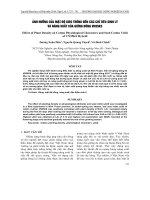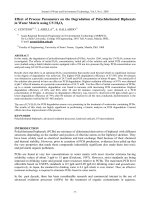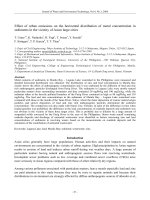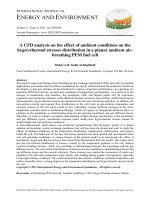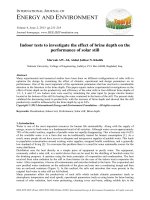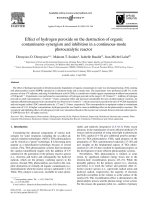- Trang chủ >>
- Khoa Học Tự Nhiên >>
- Vật lý
Effect of substrate temperature on spontaneous gan nanowire growth and optoelectronic properties
Bạn đang xem bản rút gọn của tài liệu. Xem và tải ngay bản đầy đủ của tài liệu tại đây (498.23 KB, 4 trang )
Effect of substrate temperature on spontaneous GaN nanowire growth and
optoelectronic properties
A.P. Vajpeyi
a,b,
Ã
, A. Georgakilas
a,b
, G. Tsiakatouras
a,b
, K. Tsagaraki
a,b
, M. Androulidaki
a,b
,
S.J. Chua
c
, S. Tripathy
c
a
Microelectronics Research Group, Department of Physics, University of Crete, P.O. Box 2208, 71003 Herakilon-Crete, Greece
b
Institute of Electronic Structure and Laser (IESL), FORTH, P.O. Box 2208, 71110, Herakilon-Crete, Greece
c
Institute of Materials Research and Engineering, A*STAR (Agency for Science, Technology, and Research), 3 Research Link, Singapore 117602, Singapore
article info
Article history:
Received 11 July 2008
Received in revised form
2 September 2008
Accepted 3 September 2008
Available online 10 October 2008
PACS:
78.67.Lt
Keywords:
Plasma-assisted molecular beam epitaxy
(PAMBE)
GaN nanowires (NWs)
abstract
The catalyst-free growth and the optoelectronic properties of GaN nanowires (NWs) grown on (111) Si
substrates by plasma-assisted molecular beam epitaxy have been investigated. At constant N/Ga flux
ratio, the NW morphology, density and growth rate are controlled by the substrate temperature, which
affects the gallium adatom diffusion length before desorption. An increase in substrate temperature
results in lower growth rate and smaller diameter of NWs with lower areal density NWs. Low-
temperature photoluminescence spectra at 20 K revealed that PL intensity ratio of donor-bound exciton
peak (D1X at 3.470 eV) with defect-related peak (Y
2
at 3.424 eV) increased with increase in substrate
temperature. Micro-Raman spectra showed that the GaN NWs are completely stress free irrespective of
the growth conditions.
& 2008 Elsevier B.V. All rights reserved.
III-nitrides are promising semiconductor materials because of
their application in optoelectronics and high-power electronic
devices. One of the major problems of III-nitride materials
hetroepitaxial growth is high density of threading dislocations,
of the order of 10
8
–10
10
cm
À2
, which adversely affect the device
performance. Nanodimensional nitrides such as nanowires
(NWs)/nanopillars are attractive materials for the reduction of
the dislocation density. The NWs could be free of threading
dislocations as their small lateral length could allow initially
formed threading dislocations to move out of the crystal. The free
surface at the sidewalls also permits elastic relaxation of the
strain [1]. In addition to the elimination of threading dislocations,
the NW geometry also allows the device dimensions to be scaled
down. Different techniques such as metal-organic vapor phase
epitaxy [2,3], molecular beam epitaxy (MBE) [4,5], chemical beam
epitaxy [6] and laser ablation [7,8] have been used to grow a
variety of semiconductor NWs with high crystalline quality.
Recently, Calarco et al. [9] studied the nucleation density of MBE
grown GaN NWs and their evolution in terms of growth time for a
fixed set of growth parameters. It has also been reported that the
GaN NW morphology is affected by the N/Ga flux ratio and the
substrate temperature [10–12]. However, it is desirable to
independently control the rod-like morphology of NWs in order
to optimize their crystalline quality.
In this paper, we report on the effect of substrate temperature
on the surface morphology, density, growth rate and optoelec-
tronic properties of GaN NWs spontaneously grown on n-type
(111) silicon, by nitrogen radio-frequency plasma source MBE
(RFMBE). The results suggest that during growth, Ga adatoms are
transferred from uncovered substrate areas to the GaN NWs and
the amount of transferred Ga atoms is limited by the Ga adatom
residence time on the surface, which decreases as the substrate
temperature increases. Photoluminescence spectra at 20 K
showed that PL intensity ratio of donor-bound exciton peak
(D1X) with defect-related peaks increased in the smaller diameter
NWs, grown at higher substrate temperatures.
The GaN NWs were grown without any external catalyst on n-
type (111) silicon substrates at a constant N/Ga flux ratio of 5,
using RFMBE. [13] The Si wafers were chemically cleaned [14] and
then loaded into the MBE system. The Si surface oxide was
removed by heating in the growth chamber at 800 1C for 10 min.
Then, the plasma was turned on at 300 W with a 1.35 standard
cubic centimeter per minute (sccm) nitrogen flow rate. In order to
study the effect of substrate temperature on GaN NW morphol-
ogy, the growth was performed at (a) 700 1C (sample A), (b) 750 1C
(sample B) and (c) 800 1C (sample C) for 3 h with a Ga-limited
ARTICLE IN PRESS
Contents lists available at ScienceDirect
journal homepage: www.elsevier.com/locate/physe
Physica E
1386-9477/$ - see front matter & 2008 Elsevier B.V. All rights reserved.
doi:10.1016/j.physe.2008.09.016
Ã
Corresponding author.
E-mail addresses: (A.P. Vajpeyi),
(A. Georgakilas).
Physica E 41 (2009) 427–430
nominal GaN growth rate of 166 nm/h. The substrate temperature
was monitored by a manipulator thermocouple and the un-
certainty in the substrate temperature measurement is within
1 1C. The growth experiments were monitored by in situ reflection
high-energy electron diffraction (RHEED). The sample surface
morphology was characterized by field-emission high-resolution
scanning electron microscopy (JEOL 6700FESEM). The optical
properties of the GaN NWs were investigated by low-temperature
photoluminescence at 20 K (20 K PL), and Raman spectroscopy. PL
spectra were recorded using 325 nm line excitation wavelength
from a He–Cd laser. Micro-Raman measurements were carried out
using 514.5 nm line excitations, where the scattered light was
dispersed through the JY-T64000 triple monochromatic system
attached to a liquid nitrogen cooled charge coupled device
detector. The spatial and spectral resolution of the Raman setup
is about 1.0
m
m and 0.2 cm
À1
, respectively.
During the initial stage of the growth, the RHEED shows a rings
pattern, indicating the formation of polycrystalline GaN and
silicon nitride on the major part of the Si surface. The formation of
amorphous silicon nitride layer has been previously reported by
Kim et al. and Grandal et al. [5–15] After MBE growth of 5–15 min,
the ring-like RHEED pattern gradually changed into a spotty one,
indicative for the formation of (0 0 0 1)-oriented GaN NWs. The
transition from a ring-like RHEED pattern to a spotty one
depended on the growth temperature and N/Ga flux ratio. In
general, growth at higher temperature needed longer time for the
appearance of the spotty RHEED pattern, because of reduced
coverage of the substrate surface by the GaN NWs at higher
temperature.
Fig. 1 shows the plane and cross-sectional view of the SEM
images of the GaN NWs samples A, B and C grown on (111) Si,
with N/Ga flux ratio kept constant at 5. SEM images revealed that
nanowires density decreased from 9 Â 10
9
to 2.6 Â 10
9
cm
À2
, while
the average diameter of the nanowires decreased from 90 to
70 nm, when the substrate temperature was increased from 700
and 800 1C. The GaN NWs grown at lower temperature (p750 1C)
exhibited a tapering morphology effect. The tapering of a NW
can be evaluated by the diameter difference between the top
and bottom of the individual NW. In the case of sample B, the
diameter of the GaN NW changes from 50 to 75 nm
when measured from bottom to top part of the NW. The sample
C did not show any tapering effect. Such a tapering effect for
GaN NWs grown on silicon was also reported by Meijers et al. [10].
Our results suggest that the tapering effect can be controlled
by growth conditions such as substrate temperature and N/Ga
flux ratio. In our experiments, the growth rate of the NWs along
the [0 0 01] axis was decreased with increasing growth tempera-
ture. The growth rate of the NWs grown at 700 and 750 1C
was found to be 20% higher than the nominal growth rate of
compact film formation, which would correspond to a NW
height of 498 nm. The higher growth rate of NWs compared to a
compact film suggests that Ga has redistributed to form taller
nanowires with a lower area fill factor relative to a compact
film. This could occur either by a substrate diffusion mechanism
(at low nanowire heights) or by Ga striking the sidewalls and
then diffusing to the ends (for taller nanowires). The height of the
GaN NWs grown at 800 1C (sample C) was slightly lower than
the nominal value, but within a possible range of experimental
inaccuracies of the thickness measurements. A slight NW height
reduction cannot be explained by initiation of GaN decomposition
at 800 1C, since GaN could be regrown under the high-excess flux
of nitrogen species, as N/Ga flux ratio of 5 was used. We believe
that the reduction of the GaN NW growth rate at 800 1C is due
to a reduced residence time (
t
) of Ga adatoms on the substrate
surface. The diffusion length of Ga adatoms before desorption
is proportional to (D
t
)
1/2
, where D is the diffusion coefficient
and
t
the residence time on the surface. When growth
temperature is increased, diffusion coefficient increases but
residence time is decreased and the overall effect is a reduction
in the Ga adatom diffusion length before desorption. Hence less
ARTICLE IN PRESS
Fig. 1. Plane and cross-sectional view of SEM images of GaN NWs grown at a fixed V/III flux ratio of 5 at (a, b) 700 1C, (c, d) at 750 1C and (e, f) at 800 1C.
A.P. Vajpeyi et al. / Physica E 41 (2009) 427–430428
Ga is transferred from the uncovered substrate area to the NWs.
The limited supply of Ga adatoms to the apex of the NWs limits
the growth rate and also reduces the tapering effect at higher
growth temperature. The reduction of the Ga adatom residence
time on the surface with increasing growth temperature is also
consistent with the observed temperature dependence of the
density of the GaN NWs.
Fig. 2 presents LT-PL spectra at 20 K where all the GaN NWs
samples exhibited emission peaks at 3.470 and 3.424 eV while the
reference GaN film showed an emission peak at 3.466 eV. Both the
GaN NWs and film showed donor–acceptor pair (DAP) band at
3.260–3.333 eV. The PL emission at 3.470 eV is associated with
free exciton bound to a neutral or shallow donor (D1X) and such a
PL peak was also observed by Calleja et al. [17] The PL intensity of
(D1X) peak increased with increase in growth temperature. The
slight reduction in PL intensity of sample C may be due to the less
amount of GaN NW material excited by the laser beam (reduced
NW density). The PL emission peak at 3.424 eV, observed in all
GaN NW samples, might arise from dislocations formed when
nanowires coalesce. Cheng et al. [18] and Calleja et al. [19]
reported that this peak was attributed to an exciton bound to
structural defects at the GaN/Si interfaces. The PL intensity of DAP
band was decreased significantly with increase in growth
temperature of GaN NWs, which reflects that optical quality of
the NWs increased with increase in growth temperature. Besides
reduction of DAP emission intensity, PL intensity ratio of donor-
bound exciton peak (D1X) with defect-related peak (Y
2
at
3.424 eV) was found to be increased with increase in growth
temperature, and further confirms improvement in optical quality
of NWs sample grown at higher substrate temperature. Finally, a
blue shift of about 4.070.5 meV is observed for the D1X transition
from the GaN NWs when compared to the GaN film and such a
blue-shifted (D1X) emission is associated with relaxation of the
tensile stress in the NW samples. Micro-Raman spectra further
confirm that NWs are grown stress free compared to the reference
GaN film.
Fig. 3 presents the Raman spectra of the GaN NWs and the
reference GaN film grown on Si(111). The spectra were recorded
in the zðxxÞ
¯
z scattering geometry. The spectra are dominated by
the strong E
2
(high) optical phonon peaks besides the strong
silicon peaks at 520.5 cm
À1
. The Raman spectrum of the GaN film
shows strong E
2
(high) and A
1
(LO) modes at 566.4 and 734.0 cm
À1
,
respectively, which are in agreement with Raman selection
rules for wurtzite GaN. The inset in Fig. 3 is an expansion of the
Raman spectrum in the vicinity of the E
2
(high) phonon peak of
GaN NWs and the GaN film. The E
2
(high) phonon line of the GaN
film indicates that the film is under tensile stress of
0.2570.05 GPa when compared to strain-free, 400
m
m thick,
freestanding GaN grown by HVPE [16]. The amount of strain
was evaluated using the proportionality factor of 4.3 cm
À1
GPa
À1
for hexagonal GaN. The E
2
(high) phonon line from the GaN NWs
is centered at 567.5 cm
À1
, which is the value reported for the
freestanding GaN film. The E
2
(high) phonon frequency was the
same for all the GaN NW samples grown from 700 to 800 1C.
Therefore all these GaN NWs are grown stress free on the Si
substrate. The GaN NWs samples showed very weak and broad
A
1
(LO) phonon mode. Such a broad and weak A
1
(LO) phonon
mode could be associated with residual n-type doping as high-
temperature growth on the bare Si surface induces Si migration
from the substrate and incorporate into GaN NWs [20].Itwas
shown in Ref. [20] that doping level of 2.5 Â1018 cm
À3
is sufficient
to broaden the peak. Infact we have performed electrochemical CV
measurements which confirmed that doping level in GaN NWs is
of the order of 10
19
cm
À3
.
In conclusion, we have studied the effect of growth tempera-
ture on GaN NW morphology. SEM results revealed that the
density, diameter and growth rate of GaN NWs decrease
with increase in growth temperature. This behavior is attributed
to the reduction of Ga adatom residence time on the surface
with increase in growth temperature which limits the lateral
supply of Ga atoms to the NWs. Low-temperature photolumines-
cence at 20 K showed that PL intensity ratio of D1X peak with
defect-related peaks increased indicative of improvement in
optical quality of GaN NWs with increase in growth temperature.
PL and Raman spectra revealed that all the GaN NWs are stress
free irrespective of the used growth temperature. Such GaN NWs
are promising for the fabrication of nanostructure devices as well
as for the overgrowth of low density and stress-free III-Nitrides
films since the NWs form an air-bridge-like structure with a high
aspect ratio. They may also be used as compliant buffer layer for
the growth of compact III-Nitride films and device hetrostruc-
tures.
ARTICLE IN PRESS
3.1 3.2 3.3 3.4 3.5 3.6 3.7
20K
PL Intensity (a.u)
Emission Energy (eV)
A
B
C
GaN film
Fig. 2. Low temperature PL spectra at 20 K of the GaN NWs grown at (A) 700 1C, (B)
750 1C, (C) 800 1C, and a reference GaN film grown on (111) Si.
450 500 550 600 650 700 750 800
A1(LO)
E
2
(high)
550 560 570 580
E
2
(high)
Intensity (a.u)
Raman-shift (cm
-1
)
A
B
C
Film
Intensity (a.u)
Raman-shift (cm
-1
)
A
B
C
Film
Fig. 3. Raman spectra of GaN NWs grown at (A) 70 0 1C, (B) 750 1C, (C) 800 1C, and a
reference GaN film grown on (111) Si. The inset shows an expansion of the
spectrum in the vicinity of the E
2
(high) phonon peak.
A.P. Vajpeyi et al. / Physica E 41 (2009) 427–430 429
This research was carried out in the framework of the ‘‘PARSEM’’
Marie Curie Project (MRTN-CT-2004-005583) funded by European
Union.
References
[1] F. Glas, Phys. Rev. B 74 (2006) 121302(R).
[2] F. Qian, Y. Li, S. Gradecak, D.L. Wang, C.J. Barrelet, C.M. Lieber, Nano Lett. 4
(2004) 1975.
[3] J. Su, et al., Appl. Phys. Lett. 86 (2005) 13105.
[4] R. Calarco, M. Marso, T. Richter, A.I. Aykanat, R. Meijers, A.V. Hart, T. Stoica, H.
Luth, Nano Lett. 5 (2005) 981.
[5] Y.H. Kim, J.Y. Lee, S.H. Lee, J.E. Oh, H.S. Lee, Appl. Phys. A 80 (2005) 1635.
[6] L.E. Jensen, M.T. Bjo
¨
rk, S. Jeppesen, A.I. Persson, B.J. Ohlsson, L. Samuelson,
Nano Lett. 4 (2004) 1961.
[7] A.M. Morales, C.M. Lieber, Science 279 (1998) 208.
[8] X.F. Duan, C.M. Lieber, J. Am. Chem. Soc. 122 (2000) 188.
[9] R. Calarco, R.J. Meijers, R.K. Debnath, T. Stoica, E. Sutter, H. Luth, Nano Lett. 7
(2007) 2248.
[10] R. Meijers, T. Richter, R. Calarco, T. Stoica, H.P. Bochem, H. Marso, H. Luth,
J. Cryst. Growth 289 (2006) 381.
[11] K.A. Bertness, A. Roshko, N.A. Sanford, J.M. Barker, A.V. Davydov, J. Cryst.
Growth 287 (2006) 522.
[12] Y.S. Park, S.H. Lee, J.E. Ob, C.M. Park, T.W. Kang, J. Cryst. Growth 282 (2005)
313.
[13] E. Iliopoulos, A. Adikimenakis, E. Dimakis, K. Tsagaraki, G. Konstantinidis,
A. Georgakilas, J. Cryst. Growth 278 (2005) 426.
[14] M. Kayambaki, R. Callec, G. Constantinidis, C. Papavassiliou, E. Loechtermann,
H. Krasny, N. Papadakis, P. Panayotatos, A. Georgakilas, J. Cryst. Growth 157
(1995) 300.
[15] J. Grandal, M.A. Sa
´
nchez-Garcı
´
a, E. Calleja, E. Luna, A. Trampert, Appl. Phys.
Lett. 91 (2007) 021902.
[16] L.S. Wang, K.Y. Zang, S. Tripathy, S.J. Chua, Appl. Phys. Lett. 85 (2004)
5881.
[17] E. Calleja, M.A. Sanchez-Garcıa, F. Calle, F.B. Naranjo, E. Munoz, U. Jahn,
K. Ploog, J. Sanchez, J.M. Calleja, K. Saarinen, P. Hautojarvi, Mater. Sci. Eng.
B 82 (2001).
[18] Hung-Ying Chen, Hon-Way Lin, Chang-Hong Shen, Shangjr Gwo, Appl. Phys.
Lett. 89 (2006) 243105.
[19] E. Calleja, M.A. Sa
´
nchez-Garcı
´
a, F.J. Sa
´
nchez, F. Calle, F.B. Naranjo, E. Munoz,
U. Jahn, K. Ploog, Phys. Rev. B 62 (2000) 16826.
[20] T. Kozawa, T. Kachi, Y. Taga, M. Hashimoto, N. Koide, K. Manabe, J. Appl. Phys.
75 (2) (1993).
ARTICLE IN PRESS
A.P. Vajpeyi et al. / Physica E 41 (2009) 427–430430
